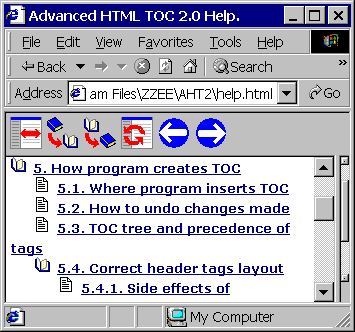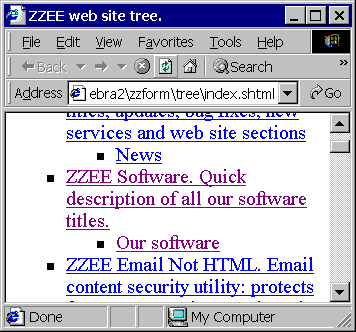Write a Table of Contents
Advanced HTML TOC creates table of contents
from headings (<Hx> tags) for your web site.
You know that correctly laid out table of contents is very important for
overall success of the publication. It is vital to have a comprehensive, yet
intuitive navigational tool, and table of contents is this tool.
But merely having table of contents is not enough. It must be thorough,
multi-level, down-to-chapter. Just in this case it is really useful and serves
as a perfect outline, helps to grasp the ideas of the document and allows to
navigate quickly. Speaking in terms of HTML, it is not enough to have a TOC that
links to the files, you also need to have a table of contents that links to each
chapter via headings and subheadings.
Advanced HTML TOC creates professional-looking, of
variable depths, numbered or not, fully customizable via templates, tables of
contents. It can handle not only HTML documents, but is also suitable for
software help authoring, as it can create TOC and navigational facilities that
are useful for both off-line (shipped with the product) and on-line help
systems. Of course, it is perfect for various instructions, technical
documentation, corporate policies and rules, that is, in any document which
needs to be well structured.
| Expanding and collapsing TOC example. |
Web site tree example. |
 |
 |
Capabilities
- Can process single or multiple files.
- Automatically uses existing named anchors inside headings (<h> tags) or creates
new ones if none.
- Automatically links TOC items to headings.
- User sets range of header <h> tags being used in TOC. E.g.: <h1>
through <h3>, or <h2> through <h6>. This can be used to
generate TOCs of various depths from the same files.
- Can process page titles, which is useful for multiple file processing.
Titles have precedence over <h1> tags.
- Completely re-entrant. If you change the file after you have
generated TOC, when you again supply it to the program, the program doesn't
create redundant named anchors and doesn't duplicate TOC. It means that you
don't have to maintain separate source and output files.
- Can put numbering (like "1.20.4.") both into TOC items
and <h> tags. If multiple files are processed then numbering is kept
in order throughout all files.
- TOC appearance is based on a template. User can create a new
template or edit existing one. You have total control over TOC style. Program is shipped with
these predefined templates:
- Tree.
- Tree with bullets.
- Expandable / collapsible tree.
- Bulleted tree with "differentiated" headers.
- Indent based tree.
- Pure text. It is indent based too.
- User specifies a place where to insert TOC with <!--TOC-->
tag. Without this tag program selects a place automatically.
- Ability to clear the code generated.
Benefits
- Simple as 1-2-3.
- No programming skills required.
- Instant professional-looking result.
- Supports expanding / collapsing table of contents, which works in any
browser and downgrades well.
- Fully customizable. Output is generated in accordance with templates. You
can change everything in a template.
Live examples
Links

